The Hypnerotomachia Poliphili published by Aldus in 1499 is that wonderful fantasy which has been called by Carl Jung, for instance, in his introduction to Linda Fierz-David's The Dream of Poliphilo (Spring Publications 1987) 'among the most beautiful printed books of all time.' I call the book wonderful because it remains a treasure trove of mystery not the least as to the identities of both author and illustrator and much else besides. Here I shall be content to discuss the inspiration for those hieroglyphic messages inscribed on the monuments which Poliphilo discovers and admires during his quest for the consummation of his love for Polia.
There are several separate possibilities or combinations of the same for the origin of the hieroglyphs of the Poliphili: the Hieroglyphica of Horapollo, the frieze from San Lorenzo fuori le muri, the frescoes in San Giustina in Padua and/or the pictures in a house in the vicinity of the Palazzo Orsini at Monte Giordano.
The Poliphili (for short), which is anonymous, is usually assumed to have been written by Francesco Colonna, a Venetian monk. Why? Because his name is found in a secret message, discovered soon after the book was published, made up of the first letters of all the chapters in the book. However this seemingly definitive identification has not given pause to the academic scribblers who have proposed, to my knowledge, at least ten other possible candidates for authorship. It was originally believed that the book was written in or before 1467 but it is now known that there must have been, at the very least, revisions right up to the date of publication in 1499 since reference is made in the book to a manuscript which Aldus says at the time was 'recently discovered'. It is now assumed that Book II of the Poliphili which contains a rather flaccid summary of the story was perhaps an early or juvenile outline of the plot, begun as early as 1467, while the main story, Book I, was written in the following decades up to the moment of publication.
So, back to the origins of the hieroglyphic script in the Poliphili., of w
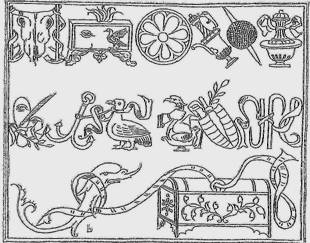
hich there are some five long messages and several other individual pictures. First the
Hieroglyphica of Horapollo. This famous manuscript aroused enormous enthusiasm in contemporary humanists who perceived that here, at last, was evidence of that primal script which united in one the two elements of the symbol, both signifier and signified, and gave direct access to an understanding of the divine realities. Although the manuscript was discovered as early as 1419 in Greece and immediately taken to Florence, it was not printed until 1505 (by Aldus) and not translated into Latin until 1515. So can Colonna have read the original manuscript or any of the copies? Let it first be said that according to Giehlow (
Die Hieroglyphen-kunde des Humanismus in der Allegorie des Renaissance page 24 note) only four manuscripts of the book from the 15th century have been identified (this excludes the famous Pirckheimer ms from the early 16th century partly illustrated by Durer). It is also the case that none of these four early mss were illustrated and the first printed illustrated edition was from Kerver in 1543 where many of the illustrations were copies of the Durer illustrations just mentioned. None of the these illustrations and indeed none of the descriptions bears anything like the meaning attributed by Colonna to the individual elements of his hieroglyphic messages.
The next possibility is the frieze from the church of San Lorenzo fuori le muri at Rome. The pulpit in this church was, in the 15th century, decorated with an ancient Roman frieze which had hieroglyphic pictures carved on it. The frieze was well-known at the time, a tourist attraction, and was subsequently moved into the Capitoline Museum where it still is. It is believed that the frieze originally came from a Roman temple - an otherwise unk
nown temple of Neptune because of the number of naval motifs in the frieze. However, as Iversen points out (
The Burlington Magazine, Vol 100, #658, Jan 1958 p 19), there is a fragment of a similar frieze still in place in the extant Temple of Vespasian so it would make sense that the Capitoline frieze also came from there although a description of the former says it is just over a meter high whereas Giehlow gives the height of the latter as .59 m high.
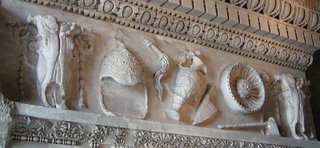
The frieze from the Temple of Vespasian
I have not seen the original Capitoline frieze but there are pictures of parts of it in several publications namely Giehlow (cited above) pp 56, 59, Ludwig Volkmann's Bilderschriften der Renaissance (Leipzig 1923) p 16, Erik Iversen's The Myth of Egypt and Its Hieroglyphs in European Tradition (Princeton 1993) and Rudolf Wittkower's Allegory and the Migration of Symbols (Thames & Hudson 1997) p 119. The last two are copied from Herwath von Hohenburg's Thesaurus Hieroglyphicorum of c 1607 one of many contemporary copies of the frieze.
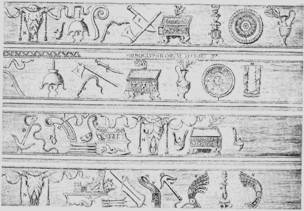
The Capitoline Frieze
The next possibility is referred to in Giehlow as the pictures in a house near the Palazzo Orsini in Monte Giordano. They are described in Geoffrey Tory's Champ Fleury of 1526, his masterpiece on the proportion of letters which led to him being appointed Royal Printer to the French king. He says (p 183) that here there is painted ' an ox's head with two horns and a hoe hanging from each horn, and above it an eye; and next that a kettle full of fire, a man's face, a vessel from which water is flowing, violets in a jar, an eye over a shoe, a ship's anchor, a crane holding a stone with one of her feet and a dolphin on a lamp which is held by a hand.' This translation is by George B. Ives from the Grolier Club edition of 1927 although Ives mistranslates 'a hoe hanging from a horn' as 'a frog hanging from each horn'. Tory could have seen this picture, according to Giehlow, during a visit to Rome in 1512. Be that as it may, this is a much more accurate depiction of what is on Poliphili picture above than what is on the frieze. But who knows, the picture may have been painted from the book rather than vice versa. Incidentally, the sloping pitcher ('a vessel from which water is flowing') is almost identical to the pitcher on the Temple of Vespasian rather than from any on the Capitoline frieze.
The next possibility are the frescoes in a hall in the convent of San Giustina in Padua. The frescoes have now largely been destroyed but they were copied by Francesco Mengardi in a beautiful series of engravings made at the end of the 18th century.

A fresco from San Giustina
It is quite obvious that some of the motifs in the frescoes are copied from Colonna or was it vice versa? The frescoes were started by Bernardo Parentino but remained unfinished at his death in 1540 and were finished later by Girolamo del Santo. We do not know when Parentino began his work but it could conceivably have been much earlier. Ludwig Volkmann in his book (cited above) quotes (p23) Léon Dorez, a 19th century French philologist, as being of the opinion that Colonna copied the frescoes and not vice versa though he provides no evidence to support this.
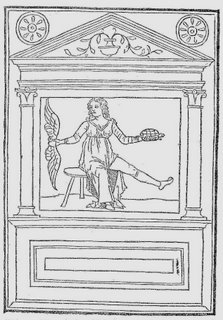
From the Poliphili
We can note also that there were references to the hieroglyphs in classical writers who give translations of a few of the symbols that have been reported to them e.g. Herodotus,l Diodorus Siculus, Pliny, Plutarch, Clement of Alexandria and others. It is no doubt possible that Colonna had read some of these authors.
Finally, there was a tradition of picture writing by means of what we now call rebuses. Giehlow (p 34) specifically refers to this as a possible forerunner of the Renaissance obsession with symbolic writing. A rebus script is included in the Champ Fleury which has some resonance with the Poliphili pictures

Fantastic letters from the Champ Fleury
and Octave Delepierre in his Rebuses (London 1870) gives examples of two types of rebuses. The first from Rondeaux d'amour in J.G. Alioni's Opera Jocunda of 1521 and the second is from a sonnet entitled Cifre quadrati et sonnette figurati from the Libro di M. Giovannibattista of 1545 and seems on first sight to be a rather childlike mixture of letters and doodles. But this may have been a more common phenomenon than we know. In the Pirckheimer edition of the Horapollo, there is a comment by Pirckheimer in an almost identical form. (Pictures of these will be posted in due course)
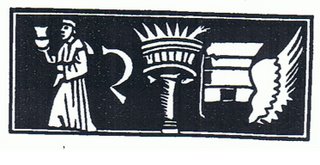
From the Rondeaux d'amour
 hich there are some five long messages and several other individual pictures. First the Hieroglyphica of Horapollo. This famous manuscript aroused enormous enthusiasm in contemporary humanists who perceived that here, at last, was evidence of that primal script which united in one the two elements of the symbol, both signifier and signified, and gave direct access to an understanding of the divine realities. Although the manuscript was discovered as early as 1419 in Greece and immediately taken to Florence, it was not printed until 1505 (by Aldus) and not translated into Latin until 1515. So can Colonna have read the original manuscript or any of the copies? Let it first be said that according to Giehlow (Die Hieroglyphen-kunde des Humanismus in der Allegorie des Renaissance page 24 note) only four manuscripts of the book from the 15th century have been identified (this excludes the famous Pirckheimer ms from the early 16th century partly illustrated by Durer). It is also the case that none of these four early mss were illustrated and the first printed illustrated edition was from Kerver in 1543 where many of the illustrations were copies of the Durer illustrations just mentioned. None of the these illustrations and indeed none of the descriptions bears anything like the meaning attributed by Colonna to the individual elements of his hieroglyphic messages.
hich there are some five long messages and several other individual pictures. First the Hieroglyphica of Horapollo. This famous manuscript aroused enormous enthusiasm in contemporary humanists who perceived that here, at last, was evidence of that primal script which united in one the two elements of the symbol, both signifier and signified, and gave direct access to an understanding of the divine realities. Although the manuscript was discovered as early as 1419 in Greece and immediately taken to Florence, it was not printed until 1505 (by Aldus) and not translated into Latin until 1515. So can Colonna have read the original manuscript or any of the copies? Let it first be said that according to Giehlow (Die Hieroglyphen-kunde des Humanismus in der Allegorie des Renaissance page 24 note) only four manuscripts of the book from the 15th century have been identified (this excludes the famous Pirckheimer ms from the early 16th century partly illustrated by Durer). It is also the case that none of these four early mss were illustrated and the first printed illustrated edition was from Kerver in 1543 where many of the illustrations were copies of the Durer illustrations just mentioned. None of the these illustrations and indeed none of the descriptions bears anything like the meaning attributed by Colonna to the individual elements of his hieroglyphic messages. The frieze from the Temple of Vespasian
The frieze from the Temple of Vespasian The Capitoline Frieze
The Capitoline Frieze A fresco from San Giustina
A fresco from San Giustina From the Poliphili
From the Poliphili Fantastic letters from the Champ Fleury
Fantastic letters from the Champ Fleury
0 Comments :
Post a Comment
<< Home